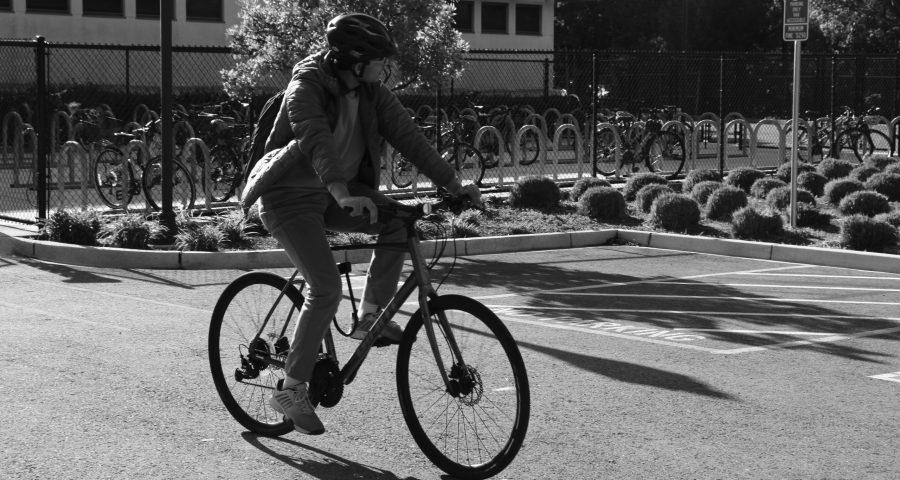To prioritize pedestrian and cyclist safety, the Palo Alto City Council voted at its Feb. 13 meeting to spend a $160,000 grant from the U.S. Department of Transportation to redesign roads throughout the city.
The council hopes this “safe system” policy will help prevent crashes and reduce the harm caused if a crash does occur.
Council of PTA Safe Routes to School Chairperson Arnout Boelens, who led the advocacy for the policy, said the city should add extra bike lanes on busy roads.
In other places, he said well-designed roundabouts could lessen the severity of crashes by safeguarding against head-on collisions.
If there are crosswalks in the middle of a street, he also said it would be beneficial to put them on speed tables to encourage people to slow down and decrease the likelihood of pedestrian-vehicle accidents.
Boelens said the safe systems approach to road safety is a different way of implementing safety than has traditionally been used in the US.
“The founding principle is that humans are vulnerable to injury and everyone on the road makes mistakes, but if someone makes a mistake, (with the ‘safe systems’ policy), it never leads to severe injury or fatality,” Boelens said. “Starting from that principle, you try to make the roads safer by accounting for things that could go wrong.”
Councilmember Julie Lythcott-Haims said the policy focuses on pedestrian and cyclist safety.
“It’s meant to get us to this goal of zero traffic fatalities,” Lythcott-Haims said. “Some people may think this is wishful thinking, but there are other jurisdictions that have achieved this by designing their streets, cycling areas and pedestrian areas more carefully.”
Councilmember Greg Tanaka said he thinks the city should implement protected bike lanes, where the car parking and the bike lane are swapped, so bikes are not immediately next to moving traffic.
“A lot of people don’t want to bike because they don’t feel safe,” Tanaka said. “In our city, we don’t have as many protected bike lanes as other cities, so people are biking (alongside) cars.”
Palo Alto Transportation Planning Manager Sylvia Star-Lack said the “safe system” distributes the responsibility for transportation safety between drivers, vehicle manufacturers, policy makers, law enforcement and those who help design the system. This division of accountability means all stakeholders will need to make changes.
Star-Lack also said the “safe system” policy prioritizes redundancy. The safe system approach works by building and reinforcing multiple layers of protection to prevent crashes from happening and minimizing the harm caused when crashes do occur.
“If one thing fails, that shouldn’t be the only thing that keeps someone alive. There should be another layer of protection,” Star-Lack said. “The other part of the approach is when something goes wrong, there would be an investigation, monitoring and changes in design, to prevent another collision of that kind, so it’s an iterative approach to improving our system.”
Star-Lack said while the council has not adopted the entire “safe system” policy yet, the city will start implementing elements of the approach because of its success at the state and federal level.
“For example, we will develop a safety action plan with the Safe Streets For All grant that we just received from the Federal Department of Transportation, and that grant requires us to use the safe systems approach in development of the action plan,” Star-Lack said.
Boelens said he received 16 letters of support from attendees at PTA meetings and collected over 450 signatures on a petition asking the council to adopt the “safe system” policy. He said he is excited to get more people on board with programs improving pedestrian safety.
“Palo Alto is exceptional in the U.S. for how many students walk and bike to school, so we hear many complaints from students (about) intersections or places they don’t feel safe,” Boelens said. “A policy like this could provide (the) foundation to finally start addressing all these issues. Hopefully it will be safer for everyone, including our PAUSD students on the road.”
Freshman Claudia Wolff de Tourreil, who usually bikes to school every day, said she thinks having many safe routes for people to get around is critical.
She said parts of her route are difficult to navigate for bikers, meaning she either has to cross a lot of major intersections or train tracks, which are both inconvenient and hazardous.
“I think that if there were more safe intersections, it would make biking a lot easier, because a lot of times I avoid the railroad crossings by biking all the way down to California Avenue,” Wolff de Tourreil said.
Lythcott-Haims said the City Council hopes to implement the “safe system” to ensure Palo Alto continues to be a city where students walk and bike to school.
“The safer our roads are, the more confidence parents and students can have in the fact that when a kid leaves home to walk or bike to school, they’re going to come home safely,” Lythcott-Haims said. “It’s going to instill confidence and a sense of security that this is a bikeable, walkable city.”
Lythcott-Haims said she thinks the policy is a recommitment to the fact that no matter how advanced technology gets, at the end of the day, City Council will help residents get from one location to another in a safe manner.
“The safety of the people who live, work and go to school in Palo Alto is our highest priority,” Lythcott-Haims said. “The safe systems approach really puts individual human beings at the center of our focus when designing transportation systems.”


